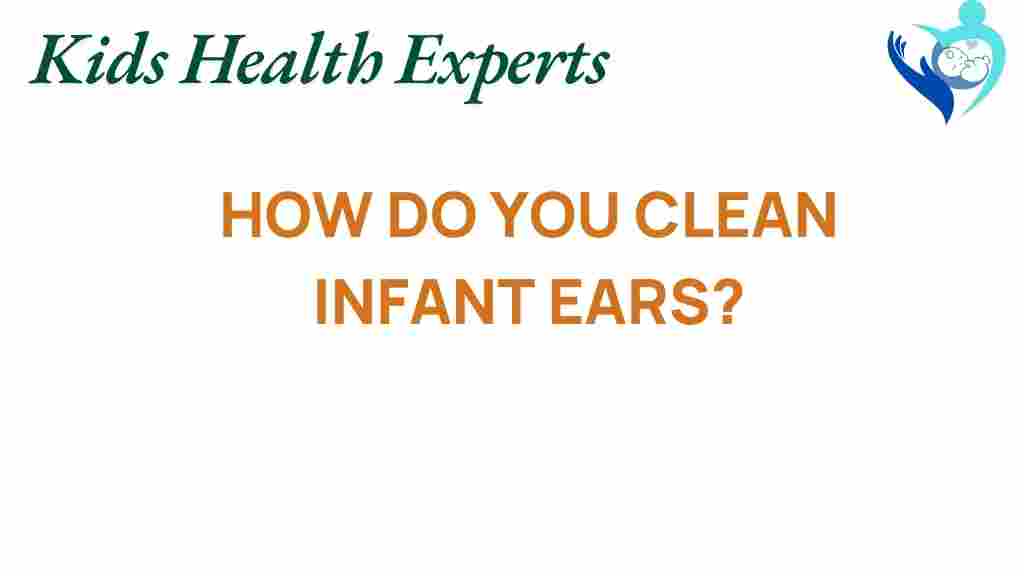The Essential Guide to Safely Cleaning Infant Ears
As parents, ensuring our little ones’ health and well-being is a top priority. One often overlooked aspect of infant health is ear hygiene. Proper infant ear cleaning can help prevent infections and promote overall health. This guide will provide you with essential tips and safe practices for cleaning your baby’s ears, ensuring you have the confidence needed for effective baby care.
Understanding Infant Ear Hygiene
Before diving into the how-to’s of earwax removal, it’s important to understand what earwax is and why it’s important. Earwax, or cerumen, is a natural substance produced by glands in the ear canal. It serves several functions:
- Traps dust and foreign particles
- Prevents dryness of the ear canal
- Has antibacterial properties that protect against infections
Typically, infants do not require regular ear cleaning since their ears are self-cleaning. However, in some cases, excessive earwax buildup may occur, requiring parental intervention. Here are some parenting tips for maintaining your infant’s ear hygiene.
When to Clean Your Infant’s Ears
It’s crucial to recognize when ear cleaning is necessary. Look for these signs:
- Visible buildup of earwax in the outer ear
- Signs of discomfort or irritation around the ears
- Unusual odors emanating from the ear
- Frequent tugging or pulling at the ears
If you notice any of these signs, it may be time to perform some gentle cleaning. Always consult with a pediatrician for advice tailored to your child’s specific needs.
Step-by-Step Process for Infant Ear Cleaning
Cleaning your baby’s ears should be done with care and caution. Here’s a step-by-step guide to safely clean your infant’s ears:
What You Will Need:
- Soft washcloth or cotton ball
- Warm water
- Baby oil or mineral oil (optional)
- Bulb syringe (if necessary)
- Gentle baby wipes
Step 1: Prepare Your Materials
Gather all the materials you need in a comfortable and well-lit area. Ensure you have everything within reach, so you won’t need to leave your infant unattended.
Step 2: Position Your Baby
Lay your baby on a flat surface, such as a changing table or bed. You can also hold your baby in your lap. Make sure they are comfortable and secure.
Step 3: Dampen the Washcloth
Take the soft washcloth or cotton ball and dampen it with warm water. Make sure it’s not too wet, as you don’t want excess water to enter the ear canal.
Step 4: Clean the Outer Ear
Gently wipe the outer part of your baby’s ear, including behind the ear and around the ear canal entrance. Avoid inserting anything into the ear canal, as it can push wax further in or cause injury.
Step 5: Use Oil for Excessive Wax (If Needed)
If you notice significant earwax buildup, you can apply a drop or two of baby oil or mineral oil in the ear. Allow it to sit for a few minutes to soften the wax. Then, use the damp washcloth to wipe away any excess wax that has loosened.
Step 6: Dry the Area
After cleaning, gently pat the area dry with a soft towel. Ensure no moisture remains in the ear, as this can lead to infections.
Step 7: Monitor for Issues
Observe your infant for any signs of discomfort or unusual behavior after cleaning. If you notice anything concerning, consult your pediatrician.
Troubleshooting Tips
Sometimes, cleaning your infant’s ears can lead to concerns. Here are some troubleshooting tips:
What If Your Baby Doesn’t Like It?
Some babies may resist having their ears cleaned. If your baby becomes fussy:
- Try to distract them with a toy or gentle music.
- Make it a part of their bath routine when they are relaxed.
- Consider doing it when they are sleepy or calm.
Excessive Wax Buildup
If you frequently notice excessive wax buildup, consult your pediatrician for advice. They may recommend professional cleaning or alternative methods for earwax removal.
Signs of Infection
Be vigilant for signs of ear infections, including:
- Fever
- Persistent crying
- Fluid drainage from the ear
- Difficulty sleeping
If you observe any of these symptoms, contact your pediatrician immediately.
Safe Practices for Infant Ear Cleaning
To ensure the safety of your infant during ear cleaning, follow these guidelines:
- Never insert cotton swabs or any objects into your baby’s ear canal.
- Keep cleaning sessions brief and gentle.
- Always wash your hands before and after cleaning your baby’s ears.
- Limit cleaning to the outer ear unless instructed otherwise by a pediatrician.
Conclusion
Maintaining proper ear hygiene is an essential part of baby care. Knowing how to safely perform infant ear cleaning can help prevent infections and ensure your child’s health remains optimal. Remember that while a little earwax is normal, excessive buildup or signs of discomfort should prompt a consultation with your pediatrician for tailored pediatric advice.
By following the steps outlined in this guide and using safe practices, you can confidently take care of your infant’s ear hygiene. For more parenting tips and child health information, check out our parenting resources.
For external guidance and advice, refer to the American Academy of Pediatrics for comprehensive information on infant care.
This article is in the category Care and created by KidsHealthExperts Team
